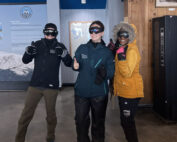Brrrrr, It’s Cold Outside, but the Rime Ice is Beautiful!
2022-03-15 14:34:34.000 – Matthew Addison, Weather Observer/Meteorologist
It’s been four months since I arrived at Mount Washington and wow, has it been chilly! In my 26+ years as a meteorologist, I can say this has indeed been the coldest weather I’ve ever experienced.
Of 147 days on the summit, only 28 have seen the temperature rise above freezing, which means it’s been below freezing 81% of my time here. While that may not seem too bad for most New Englanders, as a native Texan, this is a bit chilly.
While I do love the cold, it’s the wind that makes the temperature almost unbearable at times. During the same 147 days, the winds were blowing at or greater than hurricane strength (74 mph or higher) on 76 days, or 52% of the time. This has made wind chill temperatures dip to the lowest I’ve ever experienced in my lifetime.
As you may already know, the wind chill is how cold temperatures actually feel on your skin when wind is factored in. The wind chill temperature, as defined by the National Weather Service, is based on “the rate of heat loss from exposed skin caused by wind and cold. As the wind increases, it draws heat from the body, driving down skin temperature and eventually the internal body temperature.”
Even when properly dressed for very cold temperatures, when the wind is at or above hurricane strength, wind chill temperatures can dip to extremely dangerous levels and cut right through whatever it is you’re wearing. This past Valentine’s Day on the summit was the coldest day so far for me. We bottomed out at -24 °F with winds of 70 mph, providing a wind chill of -70 °F. I’ve experienced colder ambient temperatures before, but never a wind chill this low.
Winter days can create such beautiful landscapes across the White Mountains, whether it’s a new coating of snow that fell overnight or the aftermath of a night of freezing fog. With cold temperatures as common as they are on the summit, when you combine the subfreezing temperatures with foggy conditions you can get some amazing icing formations (in 2021, we had 321 days with at least some amount of fog recorded during a 24-hour period).
Rime ice and hoar frost are by far the most spectacular things I’ve witnessed on the summit. While hoar frost is not typically a hazard, rime ice can be extremely dangerous for aircraft. But as an observer, it’s just absolutely stunning to watch ice form throughout the night.
 Rime ice forming on rocks.
Rime ice forming on rocks.
According to the National Weather Service, rime ice is an “opaque, or milky white, deposit of ice that forms when small supercooled water droplets accumulate on the leading edges of objects that are at or below freezing.”
“Supercooled water droplets will freeze completely and quickly without spreading from the point of impact. Thus, the droplets retain their spherical shape as they freeze, creating air packets between the frozen particles. This process creates an irregular shape of the ice.”
Hoar frost is “a deposit of interlocking crystals formed by direct sublimation on objects, usually those of small diameter freely exposed to the air, such as tree branches, plants, wires, poles, etc. The deposition of hoar frost is similar to the process by which dew is formed, except that the temperature of the frosted object must be below freezing. It forms when air with a dew point below freezing is brought to saturation by cooling.”
Hoar frost and rime ice typically occur when fog from low-lying regions, accompanied by high winds, is blown uphill into the mountains. As fog rises and cools, its airborne water droplets cool to sub-zero temperatures without freezing. As the windborne drops make impact with objects, they immediately freeze and accumulate on each other, building towards the direction of the wind.
Here on the summit, rime icing and hoar frost formation happen almost daily during the winter months. Most days, the icing can grow up to three inches per hour. However, I’ve witnessed it growing over five inches per hour during our most intense weather events.
Below are some of my favorite photos I’ve taken of rime ice forming on different objects at and near the summit.
 Rime ice forming on a grade stake along the Mount Washington Auto Road.
Rime ice forming on a grade stake along the Mount Washington Auto Road.
Rime ice on the observation deck railing.
 Rime ice on the RM Young anemometer.
Rime ice on the RM Young anemometer.
 Rime ice is visible looking out our weather room window.
Rime ice is visible looking out our weather room window.
 Hoar frost on a temperature sensor.
Hoar frost on a temperature sensor.
I’m sure you can agree with me, rime ice can be a beautiful weather phenomenon to view up close. Knowing and reporting icing is an important part of being a weather observer. It’s crucial to keeping the aviation community safe. Additionally, icing can be very destructive to meteorological instruments. It can encapsulate anemometers and other meteorological instruments and if enough icing forms, this, in combination with high winds, can destroy the equipment.
Since icing forms frequently here at the observatory, we must remove it from our weather equipment hourly to ensure not only our weather observations are as accurate as possible, but to prevent any damage to the very costly sensors.
If interested in learning more about all different type of icing, I recommend visiting
this link from the National Weather Service.
Thanks for reading!
Matthew Addison, Weather Observer/Meteorologist
 Rime ice forming on rocks.
Rime ice forming on rocks. Rime ice forming on a grade stake along the Mount Washington Auto Road.
Rime ice forming on a grade stake along the Mount Washington Auto Road.
 Rime ice on the RM Young anemometer.
Rime ice on the RM Young anemometer. Rime ice is visible looking out our weather room window.
Rime ice is visible looking out our weather room window.  Hoar frost on a temperature sensor.
Hoar frost on a temperature sensor.



